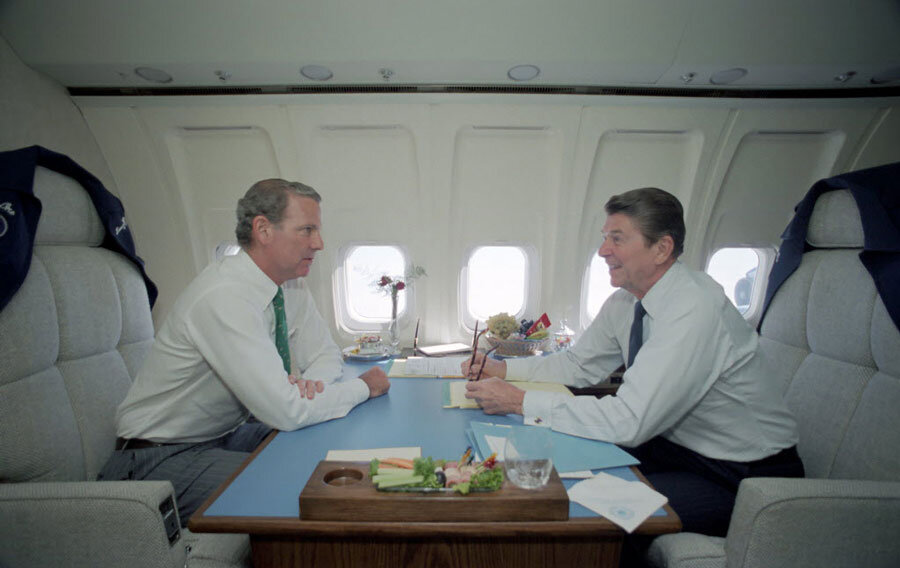GOP debate: How did Reagan Library get a real Air Force One?
Loading...
What will happen at tonight’s GOP debate at the Ronald Reagan Presidential Library in Simi Valley, Calif.? Will Donald Trump attack Jeb Bush? Will Ben Carson be a calm counterpoint? Will Carly Fiorina turn in a strong performance?
We have no idea. But there’s one question many viewers will have that we can indeed answer ahead of time. Yes, that plane behind the debaters is a real Air Force One.
Or it used to be called Air Force One when it carried one of the seven presidents it served. Within the Air Force, the modified Boeing 707 was more commonly known by its call sign, SAM 27000. It entered service in 1973 during Richard Nixon’s presidency. In fact, it’s the plane that Nixon flew to California after his resignation. President Carter flew it to Germany to greet US hostages following their release from Iran. President Reagan used it the most, mileage-wise.
Its last official flight was in 2001, when President George W. Bush flew it to Waco, Texas. After that it traveled to an airfield in San Bernardino, Calif., where it was disassembled and trucked to Simi Valley. It was reassembled at the Reagan Library, as if it were a giant model airplane. Today, it’s the centerpiece of the library’s big Air Force One pavilion, which also includes a presidential motorcade and the actual interior of a pub Reagan once visited in Ireland.
The pavilion is available for rental, by the way. It seats 1,400 for dinner. Interior tours of the plane are included in the price.
How did this aircraft end up in Reagan’s Library? Ah, that’s a good question. Historic planes are hot commodities for museums. They help drive attendance – before the arrival of the Boeing (which coincided with Reagan’s burial on the grounds) annual attendance at the Reagan Library was about 200,000. Now it’s 350,000 a year, or more.
Lobbying, in a word, is what landed this prize. At one point in his presidency, Reagan flew SAM 27000 with then-Secretary of the Air Force James McGovern. In the midst of a conversation, Reagan said, “Mr. Secretary, this is a pretty nice airplane…. Can I have it?”
Reagan went on to explain that he wanted it for his library, according to a book on the plane’s “final mission” by father and son co-authors Joel and Michael Cohen.
The turnover wasn’t final until 2001, after the 707 and its sister ship, SAM 26000, had been largely supplanted as Air Force One by a brace of Boeing 747s. It was the first former presidential aircraft to go to a presidential library, and at the time there was some grumbling from partisans of other former presidents about favoritism.
“Why does [Reagan] have a favored claim to it over Nixon, Ford, or Carter?” asked Jerry terHorst, a former Ford press secretary, in 2001.
The Reagan Library’s success in this matter has spawned some further struggles. The LBJ Library in Austin, Texas, would like the SAM 26000 sister ship, for instance. That Boeing 707 was the first to be specially configured to serve as Air Force One. It entered service in 1962, and is most famous as the aircraft President Kennedy flew to Dallas’ Love Field on Nov. 22, 1963. After JFK’s assassination, 26000 was the plane in which LBJ was sworn in as president. It carried Kennedy’s body back to Washington.
The Air Force is not giving this one up, though. It’s displayed at the National Museum of the US Air Force in Dayton, Ohio. In a 2014 letter to Ohio lawmakers, Air Force Maj. Gen. James Martin said, “The Air Force is not considering the transfer of this aircraft to the Lyndon B. Johnson Presidential Library and Museum or any other entity.”
Note to Obama library planners: The current 747s designated for use as Air Force One are getting old. They’re going to be replaced, though that won’t start until after 2016.
If the Obama complex in Chicago wants its own version of the Reagan Library’s Air Force One Pavilion, it might be time to start lobbying now.






